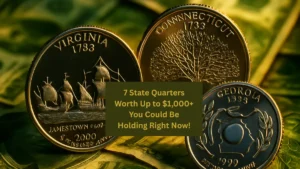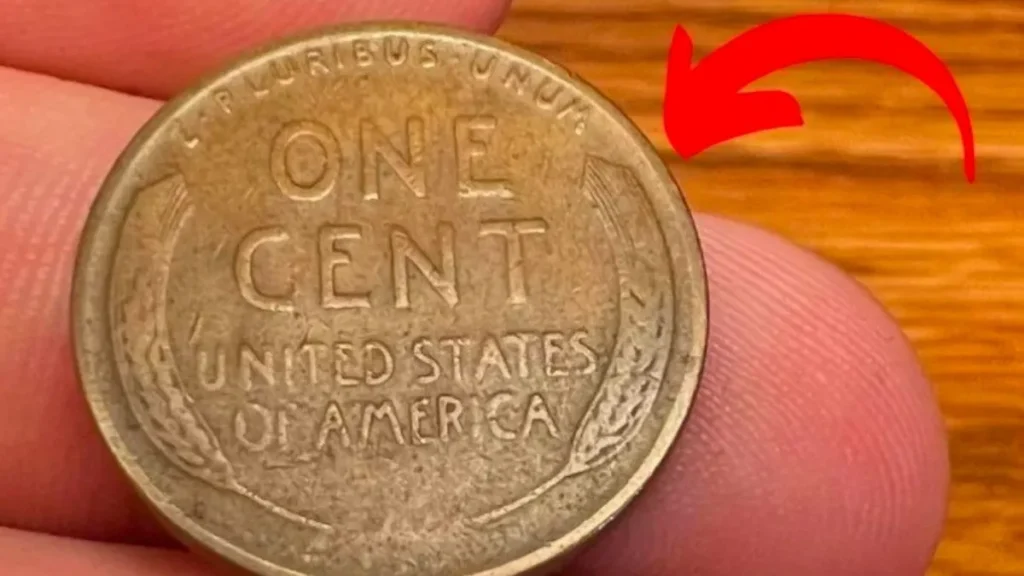If you’ve ever sorted through your spare change and wondered whether any of those state quarters might be worth more than their face value, you’re definitely not alone.
The U.S. State Quarters Program, launched in 1999, produced 50 unique designs representing each state. Along the way, a handful of rare mistakes and unusual variations have made certain coins highly valuable. Whether caused by minting errors or die variations, some state quarters have become prized collectibles that can be worth hundreds or even thousands of dollars. From the famous 2004-D Wisconsin “Extra Leaf” quarter to striking off-center errors and missing clad layers, these coins are not just money—they’re tiny pieces of history. This article highlights the 7 most valuable state quarters, explains what makes them special, and shows how you can spot them in your own collection or change. Let’s jump right in!
2004-D Wisconsin Extra Leaf Quarter (High Leaf & Low Leaf Varieties)
One of the most famous and sought-after state quarter errors is the 2004-D Wisconsin quarter featuring an extra leaf on the corn stalk. This coin, part of the Wisconsin state quarter release, is distinguished by an additional leaf appearing either high or low on the left side of the ear of corn. This unexpected feature likely resulted from damage or accidental alteration to the minting die. Collectors quickly recognized this anomaly, making the coin highly desirable. Depending on the coin’s condition and whether it shows the high or low leaf variety, it can be valued anywhere between $100 and over $1,000. The high leaf version is considered rarer and thus more valuable. This error is easy to spot with the naked eye, which makes it popular among collectors and casual treasure seekers alike.
1999-P Delaware Spitting Horse Quarter
The Delaware quarter released in 1999-P was the first coin in the 50 State Quarters Program and is known for a distinctive mint error dubbed the “Spitting Horse.” This name comes from a die crack that looks like the horse (Caesar Rodney’s mount) is spitting or drooling. The crack runs from the horse’s mouth outward toward the coin’s edge. Not all Delaware quarters feature this die crack, making the ones that do relatively rare. These error coins typically sell for $10 to $50 in circulated condition, with mint-condition examples fetching much higher prices. This coin’s significance as the very first state quarter release adds sentimental value for collectors. It’s a great example of how a minor flaw can transform an ordinary quarter into a prized collectible.
2001-P Kentucky Quarter with Double Die Obverse
The 2001-P Kentucky quarter showcases the Federal Hill mansion, the inspiration for the song “My Old Kentucky Home.” However, some of these quarters were struck with a doubled die on the obverse side, causing some parts of the design—like text—to appear slightly doubled. This occurs when the die impresses the design twice, but in slightly different positions. Doubling often appears on the date or the word “LIBERTY.” Not every doubled die coin is valuable, but clear and well-defined examples from this issue can be worth between $300 and $500 or more in uncirculated condition. These coins are especially prized by collectors who focus on die varieties and errors. Their value continues to increase as fewer high-quality specimens remain available.
2000-P South Carolina Off-Center Strike Quarter
Off-center strike errors are highly collectible due to their unique appearance, and the 2000-P South Carolina quarter has several examples. An off-center strike happens when the blank metal disc isn’t properly aligned with the dies during minting, resulting in a coin where part of the design is missing or misaligned. The value of these errors depends on how far off-center the strike is, ranging from modest premiums for slight misalignments to hundreds of dollars for dramatic off-center examples. The South Carolina quarter features the Carolina Wren and Palmetto tree, so an off-center strike can significantly distort these state symbols. Collectors love these unique errors because each off-center strike is one of a kind.
1999-P Connecticut Broadstrike Quarter
The 1999-P Connecticut quarter, depicting the historic Charter Oak tree, is known for a broadstrike error. Broadstriking happens when the collar die, which shapes the rim, fails to properly engage during minting. This causes the coin to flatten out more than usual, sometimes losing parts of its design and appearing larger or distorted. While broadstrike errors aren’t as obvious as die cracks or doubled dies, they are still highly sought after for their rarity and unusual shape. Depending on the error’s severity and the coin’s condition, broadstruck Connecticut quarters can sell for $75 to $200 or more. Being part of the first year of the State Quarters Program, 1999 errors like these are especially desirable among collectors.
2005-P Minnesota Doubled Die Quarter
Minnesota’s 2005 state quarter showcases its natural beauty, including pine trees and a lake. Certain quarters from this release have a doubled die error on the reverse side, where some tree lines appear doubled. There are more than 50 known doubled die varieties of this coin, with some showing more pronounced doubling than others. The most notable versions feature doubling clearly visible without magnification, especially in the trees to the right of the state outline. These quarters can be worth anywhere from $50 to $300 depending on the strength of the doubling and the coin’s condition. This error is popular due to the appealing design, and collectors actively seek it out, as some doubled trees look like ghost images, making each coin a small puzzle to identify.
2003-P Alabama Quarter with Clad Layer Missing
The 2003-P Alabama quarter, honoring Helen Keller, occasionally appears with a missing clad layer—one of the coin’s outer layers composed of copper and nickel. When this layer fails to bond properly, one side of the coin reveals the inner copper core, giving it a distinct copper color while the other side remains silver-toned. This dramatic mint error is easily recognized and uncommon, leading to high collector interest. These coins often sell for between $250 and over $1,000 depending on which side is affected and the coin’s overall grade. Because the error changes the coin’s composition and appearance so noticeably, it stands out immediately in any collection and is highly prized for its rarity, especially in uncirculated condition.
Conclusion
Most state quarters remain worth just their face value of 25 cents, but a rare few have seen their value soar due to unusual errors and variations. Whether it’s an extra leaf, a doubled die, or a missing clad layer, these error coins have become the prized highlights of many collections. While discovering one of these valuable quarters in everyday change is uncommon, it’s certainly not impossible. Knowing what to look for boosts your chances of finding one of these hidden treasures. So next time you handle quarters, take a closer look—you might be holding a valuable piece of numismatic history.
FAQs
- Are any state quarters worth money today?
Yes, some state quarters, especially those with mint errors or rare die varieties like the 2004-D Wisconsin “Extra Leaf” or 2005-P Minnesota Doubled Die, are worth significant amounts. - How can I tell if my quarter is valuable?
Look for error signs such as doubling, missing layers, off-center strikes, or unusual design elements. Comparing your coin to online references or consulting a coin expert can help confirm its value. - Are state quarters still in circulation?
Yes, state quarters are still commonly found in circulation. While most are common, rare error varieties occasionally surface for observant collectors. - What is the most valuable state quarter?
The 2004-D Wisconsin quarter with the “High Leaf” or “Low Leaf” error is among the most valuable, with prices reaching hundreds or even over a thousand dollars in top condition.



